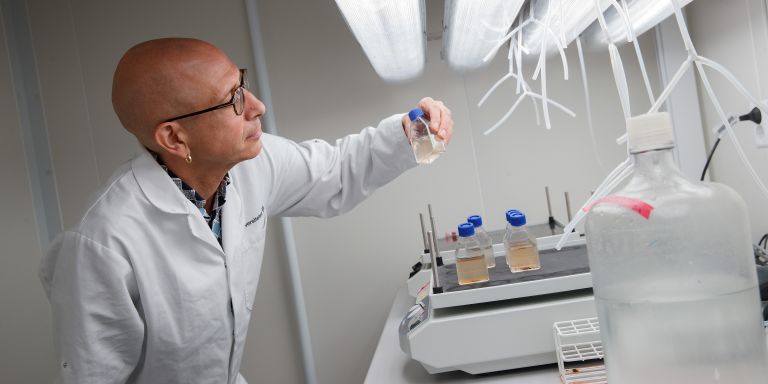
Jarone Pinhassi
Professor of Microbiology
Wallenberg Scholar
Institution:
Linnaeus University
Research field:
The importance of bacteria in the marine environment


Wallenberg Scholar
Institution:
Linnaeus University
Research field:
The importance of bacteria in the marine environment
The discovery that large quantities of bacteria in the sea carry the gene for the protein rhodopsin was published as far back as 2000. Rhodopsin enables bacteria to convert solar energy into chemical energy. Since some 70 percent of marine bacteria carry the gene, this has major implications for the global food chain.
“The discovery of rhodopsin in marine bacteria showed us a new kind of photosystem – one we don’t yet know much about. The big question is what proportion of their energy requirements the world’s biological systems capture with the help of rhodopsins,” Pinhassi says.
The discovery of rhodopsin in the sea is regarded as one of the early successes in the field of metagenomics – large-scale genomics in microbial assemblages. Craig Venter, best-known for being the first person to map the human genome, was among the first to use the method to study marine life. He sailed around the world collecting samples. As a doctoral student and postdoctoral fellow, Pinhassi was able to join the project to sequence selected bacteria.
“We managed to sequence twenty-five of the bacteria we had isolated from seawater. Several of them were able to produce rhodopsin. And we realized that no one had previously carried out experiments with bacteria capable of synthesizing the protein.”
In their first experiments Pinhassi and his colleagues were able to demonstrate that the bacteria were indeed sensitive to light. They cultured the bacteria under differing light conditions, and observed that they grew much faster in light. They were later also able to show how the ability to use light disappeared if the gene for rhodopsin was inactivated.
Every other week the researchers from Linnaeus University take samples about 10 kilometers off Kårehamn on the Baltic Island of Öland. This is the site of the Linnaeus Microbial Observatory (LMO). They have been taking water samples since 2011 in order to monitor how microbes in the sea are impacted by changes in the marine environment. The samples have given them a unique time series – essential to understand developments in the marine environment when growth and light conditions change.
“We have seen that solar energy is important for bacterial growth when nutrients in the water diminish. Initial calculations suggest that rhodopsin can increase bacterial growth by up to thirty percent,” says Pinhassi.
The protein is therefore a vital link in the global food chain. We know that microscopic algae in the oceans absorb about 140 million metric tons of carbon every day using photosynthesis – as much as all the trees and other plants on land. When the algae die, the bacteria have the task of breaking down the organic matter. To do this, they use oxygen, as well as solar energy collected by rhodopsins.
But we still do not know exactly which processes in the bacteria make best use of the sun’s rays. As a Wallenberg Scholar, Pinhassi has set himself the task of examining this at the genome level.
“The ideal would be to characterize the central processes inside the bacteria that require energy: from synthesis of degrading enzymes to their transport to the cell surface, and then decomposition of organic matter and uptake of nutrients. And we should also show how solar energy is used in each process.”
More experiments are now planned in the Baltic Sea, the Mediterranean and in the Atlantic, with the aim of examining bacterial rhodopsin requirements when the access to nutrients such as phosphorus and nitrogen is low. One of the challenges in the project is to separate bacteria from algae.
“In the sea they live right next to each other, which makes it difficult to distinguish between the quantity of energy generated by algal photosynthesis and the energy produced by rhodopsin.”
Pinhassi’s research team is using multiple techniques to ascertain which genes are active in the bacteria. Their methods include metagenomics and metatranscriptomics. They can also mark selected proteins in the bacteria using radioactivity to see whether they multiply or diminish when sunlight strikes the bacteria.
One of the greatest challenges of research is having the courage to formulate the questions to be addressed. Long-term funding gives us the courage to raise the bar.
Although Pinhassi is engaged in basic research, he mentions several applications for knowledge about rhodopsins in biochemistry and biophysics. One potential application would be to use light to transport drugs between cells in the body, a field called optogenetics.
“Another interesting area is in farming of algae or various kinds of fish. Tailored bacteria could contribute vitamins without competing for existing nutrients, since they would be obtaining their energy for biosynthesis from rhodopsin.”
Pinhassi was born and raised in Lund, and studied biology and molecular biology at Umeå University in the north of Sweden, where he also received his PhD on studies of population dynamics in bacteria. After a spell as a postdoc in Barcelona, he moved to Kalmar, where Linnaeus University was engaged in establishing a research environment in the field of marine microbiology.
“There are now some fifteen researchers focusing on aquatic topics. Together, we have created an internationally recognized environment.”
Text Magnus Trogen Pahlén
Translation Maxwell Arding
Photo Magnus Bergström